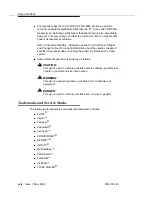
Maintenance Architecture
555-233-143
1-12
Issue 1 May 2002
Usage
The following is a list of the protocols when data is transmitted to and through the
system. The list is organized by protocol layers. See
.
Layer-1 Protocols
Layer-1 protocols are used between the terminal or host DTE and the DCE, used
between the DCE equipment and the system port, and used inside the system.
The following layer-1 protocols are used between the DTE equipment and the
DCE equipment. DCE equipment can be data modules, modems, or Data Service
Units (DSUs). A DSU is a device that transmits digital data to a particular digital
endpoint over the public network without processing the data through any
intervening private network switches.
■
RS-232 — A common physical interface used to connect DTE to DCE.
This protocol is typically used for communicating up to 19.2 kbps.
■
RS-449 — Designed to overcome the RS-232 distance and speed
restrictions and lack of modem control
■
V.35 — A physical interface used to connect DTE to a DCE. This protocol
is typically used for transmissions at 56 or 64 kbps.
The following protocols are used at layer 1 to govern communication between the
DCE equipment and the port. These protocols consist of codes inserted at the
originating DCE and stripped at the port. The DS1 protocol can be inserted at the
originating, outgoing trunk port and stripped at the destination port.
■
Digital Communications Protocol (DCP) — A standard for a 3-channel link.
This protocol sends digitized voice and digital data in frames at 160 kbps.
The channel structure consists of two information (
I
) channels and one
signaling (S) channel. Each
I
-channel provides 64 kbps of voice and/or
data communication, and the S-channel provides 8 kbps of signaling
communication between the system and DTE equipment. DCP is similar to
ISDN BRI.
■
Basic Rate Interface (BRI) — An ISDN standard for a 3-channel link,
consisting of two 64-kbps bearer (B) channels and one 16-kbps signaling
(D) channel.
■
Primary Rate Interface (PRI) — An ISDN standard that sends digitized
voice and digital data in T1 frames at 1.544-Mbps or, for countries outside
the United States, in E1 frames at 2.048-Mbps. Layer 1 (physical), layer 2
(link), and layer 3 (network) ISDN-PRI protocols are defined in AT&T
System 75 and 85 — DS1/DMI/ISDN-PRI — Reference Manual,
555-025-101. At 1.544 Mbps, each frame consists of 24 64-kbps channels
plus 8 kbps for framing. This represents 23 B channels plus 1 D channel.
The maximum user rate is 64 kbps for voice and data. The maximum
distances are based on T1 limitations. At 2.048 Mbps, each E1 frame
consists of 32 64-kbps channels.
Summary of Contents for S8700 Series
Page 50: ...Maintenance Architecture 555 233 143 1 26 Issue 1 May 2002 ...
Page 74: ...Initialization and Recovery 555 233 143 3 12 Issue 1 May 2002 ...
Page 186: ...Alarms Errors and Troubleshooting 555 233 143 4 112 Issue 1 May 2002 ...
Page 232: ...Additional Maintenance Procedures 555 233 143 5 46 Issue 1 May 2002 ...
Page 635: ...status psa Issue 1 May 2002 7 379 555 233 143 status psa See status tti on page 7 406 ...
Page 722: ...Maintenance Commands 555 233 143 7 466 Issue 1 May 2002 ...
















































